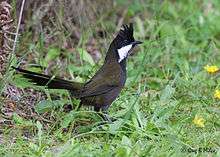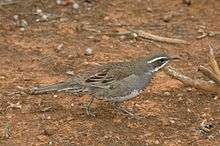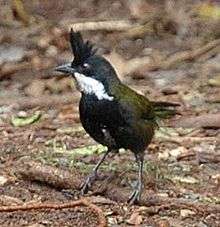Psophodidae
Psophodidae is a family of passerine birds native to Australia and nearby areas. It has a complicated taxonomic history and different authors vary in which birds they include in the family. In the strictest sense, it includes only the 5 or 6 species of whipbirds and wedgebills (Psophodes and Androphobus), but some authors also includes at the quail-thrushes (Cinclosoma), 8 species of ground-dwelling birds found in Australia and New Guinea, and the jewel-babblers (Ptilorrhoa), 3 or 4 species found in rainforest in New Guinea. Others place them in their own family, the Cinclosomatidae. The Malaysian rail-babbler (Eupetes macrocerus) was formerly sometimes placed in this family, which would then be called Eupetidae.
| Psophodidae | |
|---|---|
 | |
| Eastern whipbird (Psophodes olivaceus) | |
| Scientific classification | |
| Kingdom: | Animalia |
| Phylum: | Chordata |
| Class: | Aves |
| Order: | Passeriformes |
| Suborder: | Passeri |
| Family: | Psophodidae Bonaparte, 1854 |
| Genera | |
|
See list below | |
Taxonomy
The quail-thrushes, jewel-babblers, whipbirds and wedgebills were traditionally included with the logrunners (Orthonyx) in the family Orthonychidae.[1] Sometimes the Malaysian rail-babbler and blue-capped ifrit (Ifrita kowaldi) were also included in the family.[2] In 1985, Sibley and Ahlquist found that the logrunners were not related to the others and included only the logrunners in the Orthonychidae.[3] They treated the others as the subfamily Cinclosomatinae within their expanded family Corvidae.[4]
A number of authors later treated the quail-thrushes and allies as the family Cinclosomatidae, a name first coined by Gregory Mathews in 1921–1922. However, if the whipbirds are included in the family, the older name Psophodidae Bonaparte, 1854 has priority. If the Malaysian rail-babbler is also included, the name Eupetidae Bonaparte, 1850 has priority.[3]
The Malaysian rail-babbler has now been shown to be unrelated to the others, probably being an early offshoot of the Passerida.[5] Another study found the quail-thrushes and jewel-babblers to be related to each other but did not show them to have a close relationship with Psophodes or Ifrita.[6]
Description
Whipbirds and wedgebills are 19–31 cm long. They are mainly olive-green or brown in colour and have a crest.[7]
Distribution and habitat
The whipbirds and wedgebills are all found in Australia, occurring in a range of habitats from rainforest to arid scrub.[7] The western whipbird is considered to be near-threatened because of habitat loss and fires while the Papuan whipbird is classed as data deficient.[8][9]
Behaviour

They are terrestrial birds which fly fairly weakly and prefer to squat or run when disturbed.[1] They forage on the ground feeding mainly on insects and other invertebrates.[10] In the desert, quail-thrushes also eat some seeds.[1]
They build a cup-shaped nest among shrubs or on the ground. Two or three eggs are laid.[10]
Species list

- Genus Androphobus
- Papuan whipbird, Androphobus viridis
- Genus Psophodes
- Eastern whipbird, Psophodes olivaceus
- Black-throated whipbird, Psophodes nigrogularis
- White-bellied whipbird, Psophodes leucogaster
- Chiming wedgebill, Psophodes occidentalis
- Chirruping wedgebill, Psophodes cristatus
References
- Roberson, Don (2004) Quail-thrushes Cinclosomatidae, Bird Families of the World. Accessed 4 January 2010.
- Howard, Richard & Alick Moore (1980) A complete checklist of the Birds of the World, 1st ed., Oxford University Press, Oxford.
- Christidis, Les & Walter Boles (2008) Systematics and Taxonomy of Australian Birds, CSIRO Publishing.
- Sibley's Sequence: Passeriformes. Accessed 4 January 2010.
- Jønsson, K.A., J. Fjeldså, P.G.P. Ericson, and M. Irestedt (2007) Systematic placement of an enigmatic Southeast Asian taxon Eupetes macrocerus and implications for the biogeography of a main songbird radiation, the Passerida, Biology Letters 3(3):323–326.
- Norman, Janette A., Per G.P. Ericson, Knud A. Jønsson, Jon Fjeldså & Les Christidis (2009) A multi-gene phylogeny reveals novel relationships for aberrant genera of Australo-Papuan core Corvoidea and polyphyly of the Pachycephalidae and Psophodidae (Aves: Passeriformes), Molecular Phylogenetics and Evolution, 52:488–497.
- Pizzey, Graham & Frank Knight (1997) Field Guide to the Birds of Australia, HarperCollins, London, UK.
- BirdLife International (2009) ["Archived copy". Archived from the original on 2007-07-10. Retrieved 2012-12-13.CS1 maint: archived copy as title (link)/datazone/species/index.html?action=SpcHTMDetails.asp&sid=5609&m=0 Species factsheet: Psophodes nigrogularis]. Downloaded from "Archived copy". Archived from the original on 2007-07-10. Retrieved 2012-12-13.CS1 maint: archived copy as title (link) on 4 January 2010.
- BirdLife International (2009) ["Archived copy". Archived from the original on 2007-07-10. Retrieved 2012-12-13.CS1 maint: archived copy as title (link)/datazone/species/index.html?action=SpcHTMDetails.asp&sid=5607&m=0 Species factsheet: Androphobus viridis]. Downloaded from "Archived copy". Archived from the original on 2007-07-10. Retrieved 2012-12-13.CS1 maint: archived copy as title (link) on 4 January 2010.
- Perrins, Christopher, ed. (2004) The New Encyclopedia of Birds, Oxford University Press, Oxford.